The Magic Flute
The Magic Flute (German: Die Zauberflöte, pronounced [diː ˈtsaʊbɐˌfløːtə] ⓘ), K. 620, is an opera in two acts by Wolfgang Amadeus Mozart to a German libretto by Emanuel Schikaneder. The work is in the form of a Singspiel, a popular form during the time it was written that included both singing and spoken dialogue.[lower-alpha 1] The work premiered on 30 September 1791 at Schikaneder's theatre, the Freihaus-Theater auf der Wieden in Vienna, just two months before the composer's premature death. Still a staple of the opera repertory,[2] its popularity was reflected by two immediate sequels, Peter Winter's Das Labyrinth oder Der Kampf mit den Elementen. Der Zauberflöte zweyter Theil (1798) and a fragmentary libretto by Johann Wolfgang von Goethe titled The Magic Flute Part Two.
| Die Zauberflöte The Magic Flute | |
|---|---|
| Singspiel by W. A. Mozart | |
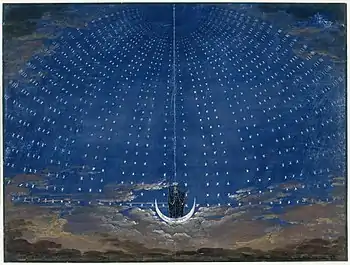 The arrival of the Queen of the Night. Stage set by Karl Friedrich Schinkel for an 1815 production. | |
| Librettist | Emanuel Schikaneder |
| Language | German |
| Premiere | |
The allegorical plot was influenced by Schikaneder and Mozart's interest in Freemasonry and concerns the initiation of Prince Tamino. Enlisted by the Queen of the Night to rescue her daughter Pamina from the high priest Sarastro, Tamino comes to admire the high ideals of the latter and he and Pamina both join Sarastro's community, while the Queen and her allies are vanquished.
Composition
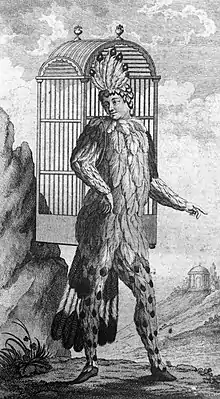
The opera was the culmination of a period of increasing involvement by Mozart with Schikaneder's theatrical troupe, which since 1789 had been the resident company at the Theater auf der Wieden. Mozart was a close friend of one of the singer-composers of the troupe, tenor Benedikt Schack (the first Tamino), and had contributed to the compositions of the troupe, which were often collaboratively written. Mozart's participation increased with his contributions to the 1790 collaborative opera Der Stein der Weisen (The Philosopher's Stone), including the duet ("Nun liebes Weibchen", K. 625/592a) among other passages. Like The Magic Flute, Der Stein der Weisen was a fairy-tale opera and can be considered a kind of precursor; it employed much the same cast in similar roles.[3]
The libretto for The Magic Flute, written by Schikaneder, is thought by scholars to be based on many sources. Some works of literature current in Vienna in Schikaneder's day that may have served as sources include the medieval romance Yvain by Chrétien de Troyes, the novel Life of Sethos by Jean Terrasson, and the essay "On the mysteries of the Egyptians" by Ignaz von Born. The libretto is also a natural continuation of a series of fairy tale operas produced at the time by Schikaneder's troupe, including an adaptation of Sophie Seyler's Singspiel Oberon as well as Der Stein der Weisen.[4] Especially for the role of Papageno, the libretto draws on the Hanswurst tradition of the Viennese popular theatre. Many scholars also acknowledge an influence of Freemasonry.[lower-alpha 2]
It appears that in this opera two references to Antonio Salieri's music are included. The first is that the Papageno–Papagena duet is similar to the Cucuzze cavatina in Salieri's Prima la musica e poi le parole. Both are centred around musical-textual playfulness with humorous bird-like utterances of pseudo-Italian words.[5] The Magic Flute also echoes Salieri's music in that Papageno's whistle is based on a motif borrowed from Salieri's Concerto for Clavicembalo in B-flat major.[6]
Premiere and reception
The opera was premiered in Vienna on 30 September 1791 at the suburban Freihaus-Theater auf der Wieden.[7] Mozart conducted the orchestra,[lower-alpha 3] Schikaneder himself played Papageno, while the role of the Queen of the Night was sung by Mozart's sister-in-law Josepha Hofer.
On the reception of the opera, Mozart scholar Maynard Solomon writes:
Although there were no reviews of the first performances,[9] it was immediately evident that Mozart and Schikaneder had achieved a great success, the opera drawing immense crowds and reaching hundreds of performances during the 1790s.[10]
As Mozart's letters show, he was very pleased to have achieved such a success. Solomon continues:
Mozart's delight is reflected in his last three letters, written to Constanze, who with her sister Sophie was spending the second week of October in Baden. "I have this moment returned from the opera, which was as full as ever", he wrote on 7 October, listing the numbers that had to be encored. "But what always gives me the most pleasure is the silent approval! You can see how this opera is becoming more and more esteemed." ... He went to hear his opera almost every night, taking along [friends and] relatives.[10]
The opera celebrated its 100th performance in November 1792, though Mozart did not have the pleasure of witnessing this milestone, as he had died on 5 December 1791. The opera was first performed outside Vienna (21 September 1792) in Lemberg,[11] then in Prague. It then made "triumphal progress through Germany's opera houses great and small",[12] and with the early 19th century spread to essentially all the countries of Europe—and eventually, everywhere in the world—where opera is cultivated.[13]
As Branscombe documents, the earlier performances were often of highly altered, sometimes even mutilated, versions of the opera (see Ludwig Wenzel Lachnith). Productions of the past century have tended to be more faithful to Mozart's music, though faithful rendering of Mozart and Schikaneder's original (quite explicit) stage directions and dramatic vision continues to be rare; with isolated exceptions, modern productions strongly reflect the creative preferences of the stage director.[14]
The Magic Flute is among the most frequently performed of all operas.[15][16]
First publication
On 28 December 1791, three and a half weeks after Mozart's death, his widow Constanze offered to send a manuscript score of The Magic Flute to the electoral court in Bonn. Nikolaus Simrock published this text in the first full-score edition (Bonn, 1814), claiming that it was "in accordance with Mozart's own wishes" (Allgemeine musikalische Zeitung, 13 September 1815).[17][18]
Themes
The Magic Flute is noted for its prominent Masonic elements,[19] although some scholars hold that the Masonic influence is exaggerated.[20][21][22] Schikaneder and Mozart were Freemasons, as was Ignaz Alberti, engraver and printer of the first libretto.[23] The opera is also influenced by Enlightenment philosophy and can be regarded as advocating enlightened absolutism. The Queen of the Night is seen by some to represent a dangerous form of obscurantism, by others to represent Roman Catholic Empress Maria Theresa,[24] who banned Freemasonry from Austria.[25] Still others see the Roman Catholic Church itself, which was strongly anti-Masonic.[26] Likewise, the literature repeatedly addresses the fact that the central theme of the work is not only "love," but also becoming a better person by overcoming trials (similar to Wagner's Parsifal later on).[27]
Roles
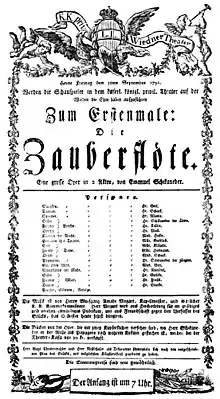
| Role | Voice type[28] | Contemporary classification[29] |
Premiere cast, 30 September 1791 Conductor: Wolfgang Amadeus Mozart |
|---|---|---|---|
| Tamino | tenor | Benedikt Schack | |
| Papageno | bass | baritone | Emanuel Schikaneder |
| Pamina | soprano | Anna Gottlieb | |
| The Queen of the Night[lower-alpha 5] | soprano | coloratura soprano | Josepha Hofer |
| Sarastro | bass | Franz Xaver Gerl | |
| Three ladies | 3 sopranos | sopranos, mezzo-soprano | Mlle Klöpfer, Mlle Hofmann, Elisabeth[30] Schack |
| Monostatos | tenor | baritone | Johann Joseph Nouseul |
| Three child-spirits | soprano[lower-alpha 6] | treble, alto, mezzo-soprano | Anna Schikaneder; Anselm Handelgruber; Franz Anton Maurer |
| Speaker of the temple | bass | bass-baritone | Herr Winter |
| First Priest | tenor | Johann Michael Kistler | |
| First armoured man | |||
| Second Priest | bass | Urban Schikaneder | |
| Third Priest | speaking role | bass | Herr Moll |
| Second armoured man | bass | ||
| Papagena | soprano | Barbara Gerl | |
| Three slaves | speaking roles | bass, 2 tenors | Karl Ludwig Giesecke, Herr Frasel, Herr Starke |
| Priests, women, people, slaves, chorus | |||
The names of the performers at the premiere are taken from a preserved playbill for this performance (at right), which does not give full names; "Hr." = Herr, Mr.; "Mme." = Madame, Mrs.; "Mlle." = Mademoiselle, Miss.[31][32]
While the female roles in the opera are assigned to different voice types, the playbill for the premiere performance referred to all of the female singers as "sopranos". The casting of the roles relies on the actual vocal range of the part.[33]
Instrumentation
The work is scored for two flutes (one doubling on piccolo), two oboes, two clarinets (doubling basset horns), two bassoons, two horns, two trumpets, three trombones (alto, tenor, and bass), timpani and strings. It also requires a four-part chorus for several numbers (notably the finales of each act). Mozart also called for a stromento d'acciaio (instrument of steel) to perform Papageno's magic bells. This instrument has since been lost to history, though modern day scholars believe it to be a keyed glockenspiel, which is usually replaced with a celesta in modern-day performances.[34]
Charles Rosen has remarked on the character of Mozart's orchestration:
Die Zauberflöte has the greatest variety of orchestral color that the eighteenth century was to know; the very lavishness, however, is paradoxically also an economy as each effect is a concentrated one, each one—Papageno's whistle, the Queen of the Night's coloratura, the bells, Sarastro's trombones, even the farewell in scene 1 for clarinets and pizzicato strings—a single dramatic stroke."[35]
Synopsis
The opera begins with a brassy cadence associated with the Priests of the Temple of Wisdom, and transitions to a lively fugue, which Mozart composed after the other parts of the opera were complete.[36]
Scene 1: A rough, rocky landscape
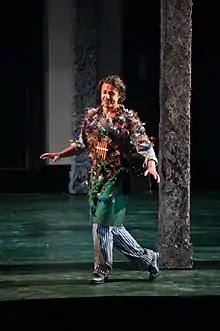
Tamino, a handsome prince lost in a distant land, is pursued by a serpent and asks the gods to save him (aria: "Zu Hilfe! Zu Hilfe!" / Help! Help!, segued into trio "Stirb, Ungeheuer, durch uns're Macht!" / Die, monster, by our might!). He faints, and three ladies, attendants of the Queen of the Night, appear and kill the serpent. They find the unconscious prince extremely attractive, and each of them tries to persuade the other two to leave. After arguing, they reluctantly decide to leave together.
Tamino wakes up, and is surprised to find himself still alive. Papageno enters dressed as a bird. He describes his life as a bird-catcher, complaining he has no wife or girlfriend (aria: "Der Vogelfänger bin ich ja" / The birdcatcher am I indeed). Tamino introduces himself to Papageno, thinking Papageno killed the serpent. Papageno happily takes the credit – claiming he strangled it with his bare hands. The three ladies suddenly reappear and instead of giving Papageno wine, cake and figs, they give him water and a stone, and place a padlock over his mouth as a warning not to lie. They give Tamino a portrait of the Queen of the Night's daughter Pamina, with whom Tamino falls instantly in love (aria: "Dies Bildnis ist bezaubernd schön" / This image is enchantingly beautiful).
The ladies return and tell Tamino that Pamina has been captured by Sarastro, whom they describe as a powerful, evil demon. Tamino vows to rescue Pamina. The Queen of the Night appears and promises Tamino that Pamina will be his if he rescues her from Sarastro (Recitative and aria: "O zittre nicht, mein lieber Sohn" / Oh, tremble not, my dear son!). The Queen leaves and the ladies remove the padlock from Papageno's mouth with a warning not to lie any more. They give Tamino a magic flute which has the power to change sorrow into joy. They give Papageno magic bells for protection, telling him to go with Tamino. The ladies introduce three child-spirits, who will guide Tamino and Papageno to Sarastro's temple. Together Tamino and Papageno set forth (Quintet: "Hm! Hm! Hm! Hm!").
Scene 2: A room in Sarastro's palace
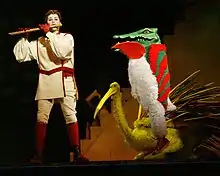
Pamina is dragged in by Sarastro's slaves, apparently having tried to escape. Monostatos, a blackamoor and chief of the slaves, orders the slaves to chain her and leave him alone with her. Papageno, sent ahead by Tamino to help find Pamina, enters (Trio: "Du feines Täubchen, nur herein!" / Just come in, you fine little dove!). Monostatos and Papageno are each terrified by the other's strange appearance and both flee. Papageno returns and announces to Pamina that her mother has sent Tamino to save her. Pamina rejoices to hear that Tamino is in love with her. She offers sympathy and hope to Papageno, who longs for a wife. Together they reflect on the joys and sacred duties of marital love (duet: "Bei Männern welche Liebe fühlen" / In men, who feel love).
Finale. Scene 3: A grove in front of a temple
The three child-spirits lead Tamino to Sarastro's temple, promising that if he remains patient, wise and steadfast, he will succeed in rescuing Pamina (Quartet: "Zum Ziele führt dich diese Bahn" / This path leads you to your goal). Tamino approaches the left-hand entrance and is denied access by voices from within. The same happens when he goes to the entrance on the right. But from the entrance in the middle, an old priest appears and lets Tamino in. (The old priest is referred to as "The Speaker" in the libretto, but his role is a singing role.) He tells Tamino that Sarastro is benevolent, not evil, and that he should not trust the Queen of the Night. He promises that Tamino's confusion will be lifted when Tamino approaches the temple in a spirit of friendship. Tamino plays his magic flute. Animals appear and dance, enraptured, to his music. Tamino hears Papageno's pipes sounding offstage, and hurries off to find him (aria: "Wie stark ist nicht dein Zauberton" / How strong is thy magic tone).

Papageno and Pamina enter, searching for Tamino (trio: "Schnelle Füße, rascher Mut" / Swift steps, ready courage). They are recaptured by Monostatos and his slaves. Papageno plays his magic bells, and Monostatos and his slaves begin to dance, and exit the stage, still dancing, mesmerised by the beauty of the music (chorus: "Das klinget so herrlich" / That sounds so splendid). Papageno and Pamina hear the sound of Sarastro's retinue approaching. Papageno is frightened and asks Pamina what they should say. She answers that they must tell the truth. Sarastro enters, with a crowd of followers. (chorus: "Es lebe Sarastro!" / Long live Sarastro!) Pamina falls at Sarastro's feet and confesses that she tried to escape because Monostatos had forced his attentions on her. Sarastro receives her kindly and assures her that he wishes only for her happiness. But he refuses to return her to her mother, whom he describes as a proud, headstrong woman, and a bad influence on those around her. Pamina, he says, must be guided by a man.
Monostatos brings in Tamino. The two lovers see one another for the first time and embrace, causing indignation among Sarastro's followers. Monostatos tells Sarastro that he caught Papageno and Pamina trying to escape, and demands a reward. Sarastro, however, punishes Monostatos for his lustful behaviour toward Pamina, and sends him away. He announces that Tamino must undergo trials of wisdom in order to become worthy as Pamina's husband. The priests declare that virtue and righteousness will sanctify life and make mortals like gods ("Wenn Tugend und Gerechtigkeit" / If virtue and justice).
Scene 1: A grove of palms
The council of priests of Isis and Osiris, headed by Sarastro, enters to the sound of a solemn march. Sarastro tells the priests that Tamino is ready to undergo the ordeals that will lead to enlightenment. He invokes the gods Isis and Osiris, asking them to protect Tamino and Pamina (Aria and chorus: "O Isis und Osiris / O Isis and Osiris").
Scene 2: The courtyard of the Temple of Ordeal
Tamino and Papageno are led in by two priests for the first trial. The two priests advise Tamino and Papageno of the dangers ahead of them, warn them of women's wiles and swear them to silence (Duet: "Bewahret euch von Weibertücken / Keep yourselves from women's tricks"). The three ladies appear and try to frighten Tamino and Papageno into speaking. (Quintet: "Wie, wie, wie" / How, how, how) Papageno cannot resist answering the ladies, but Tamino remains aloof, angrily instructing Papageno not to listen to the ladies' threats and to keep quiet. Seeing that Tamino will not speak to them, the ladies withdraw in confusion.
Scene 3: A garden
Pamina is asleep. Monostatos approaches and gazes upon her with rapture. (Aria: "Alles fühlt der Liebe Freuden" / All feel the joys of love) He is about to kiss the sleeping Pamina, when the Queen of the Night appears. Monostatos hides. In response to the Queen's questioning, Pamina explains that Tamino is joining Sarastro's brotherhood and that she is thinking of accompanying him. The Queen is not pleased. She explains that her husband, the previous owner of the temple, on his deathbed gave the ownership to Sarastro instead of to her, rendering the Queen powerless (this is in the original libretto, but is usually omitted from modern productions, to shorten the scene with Pamina and her mother). She gives Pamina a dagger, ordering her to kill Sarastro with it and threatening to disown her if she does not. (Aria: "Der Hölle Rache kocht in meinem Herzen" / Hell's vengeance boils in my heart). She leaves. Monostatos returns and tries to force Pamina's love by threatening to reveal the Queen's plot, but Sarastro enters and drives him off. Pamina begs Sarastro to forgive her mother and he reassures her that revenge and cruelty have no place in his domain (Aria: "In diesen heil'gen Hallen" / Within these sacred halls).
Scene 4: A hall in the Temple of Ordeal
Tamino and Papageno are led in by priests, who remind them that they must remain silent. Papageno complains of thirst. An old woman enters and offers Papageno a cup of water. He drinks and teasingly asks whether she has a boyfriend. She replies that she does and that his name is Papageno. She disappears as Papageno asks for her name, and the three child-spirits bring in food, the magic flute, and the bells, sent from Sarastro (Trio: "Seid uns zum zweiten Mal willkommen" / We welcome you a second time). Tamino begins to play the flute, which summons Pamina. She tries to speak with him, but Tamino, bound by his vow of silence, cannot answer her, and Pamina begins to believe that he no longer loves her. (Aria: "Ach, ich fühl's, es ist verschwunden" / Oh, I feel it, it is gone) She leaves in despair.
Scene 5: The pyramids
.jpg.webp)
The priests celebrate Tamino's successes so far, and pray that he will succeed and become worthy of their order (Chorus: "O Isis und Osiris" / O Isis and Osiris). Pamina is brought in and Sarastro instructs Pamina and Tamino to bid each other farewell before the greater trials ahead, alarming them by describing it as their "final farewell". (Trio: Sarastro, Pamina, Tamino – "Soll ich dich, Teurer, nicht mehr sehn?" / Shall I see you no more, dear one? — Note: In order to preserve the continuity of Pamina's suicidal feelings, this trio is sometimes performed earlier in act 2, preceding or immediately following Sarastro's aria "O Isis und Osiris".[lower-alpha 7][37]) They exit and Papageno enters. The priests grant his request for a glass of wine and he expresses his desire for a wife. (Aria: "Ein Mädchen oder Weibchen" / A girl or a woman). The elderly woman reappears and warns him that unless he immediately promises to marry her, he will be imprisoned forever. When Papageno promises to love her faithfully (muttering that he will only do this until something better comes along), she is transformed into the young and pretty Papagena. Papageno rushes to embrace her, but the priests drive him back, telling him that he is not yet worthy of her.
Finale. Scene 6: A garden
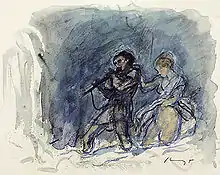
The three child-spirits hail the dawn. They observe Pamina, who is contemplating suicide because she believes Tamino has abandoned her. The child-spirits restrain her and reassure her of Tamino's love. (Quartet: "Bald prangt, den Morgen zu verkünden" / To herald the morning, soon will shine). There is then a scene change without interrupting the music, leading into scene 7.
Scene 7: Outside the Temple of Ordeal
Two men in armor lead in Tamino. They recite one of the formal creeds of Isis and Osiris, promising enlightenment to those who successfully overcome the fear of death ("Der, welcher wandert diese Strasse voll Beschwerden" / He who walks this path weighed down with cares). This recitation takes the musical form of a Baroque chorale prelude, to a tune inspired by Martin Luther's hymn "Ach Gott, vom Himmel sieh darein" (Oh God, look down from heaven).[lower-alpha 8][39] Tamino declares that he is ready to be tested. Pamina calls to him from offstage. The men in armour assure him that the trial by silence is over and he is free to speak with her. Pamina enters and declares her intention to undergo the remaining trials with him. She hands him the magic flute to help them through the trials ("Tamino mein, o welch ein Glück! / Oh, what luck, my Tamino!"). Protected by the music of the magic flute, they pass unscathed through chambers of fire and water. Offstage, the priests hail their triumph and invite the couple to enter the temple. There is then a scene change without interrupting the music, leading into scene 8.
Scene 8: A garden with a tree
Papageno despairs at having lost Papagena and decides to hang himself (Aria/Quartet: "Papagena! Papagena! Papagena! Weibchen, Täubchen, meine Schöne" / Papagena! Papagena! Papagena! Dear woman, dear dove, my beauty) The three child-spirits appear and stop him. They advise him to play his magic bells to summon Papagena. She appears and, united, the happy couple stutter in astonishment and make bird-like courting sounds at each other. They plan their future and dream of the many children they will have together (Duet: "Pa... pa... pa...").[lower-alpha 9] There is then a scene change without interrupting the music, leading into scene 9.
Scene 9: A rocky landscape outside the temple; night
The traitorous Monostatos appears with the Queen of the Night and her three ladies. They plot to destroy the temple ("Nur stille, stille" / Just quiet, quiet) and the Queen confirms that she has promised her daughter Pamina to Monostatos. But before the conspirators can enter the temple, they are magically cast out into eternal night. There is then a scene change without interrupting the music, leading into scene 10.
Scene 10: The Temple of the Sun
Sarastro announces the sun's triumph over the night, and hails the dawn of a new era of wisdom and brotherhood. Animals appear again and dance in the sun.[40]
Some musical numbers
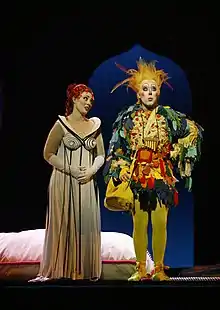
Act 1
- "Der Vogelfänger bin ich ja" (The birdcatcher am I) – Papageno, scene 1
- "Dies Bildnis ist bezaubernd schön" (This image is enchantingly beautiful) – Tamino, scene 1
- "O zittre nicht, mein lieber Sohn" (Oh, tremble not, my beloved son) – The Queen of the Night, scene 1
- "Bei Männern, welche Liebe fühlen" (In men, who feel love) – Pamina and Papageno (duet), scene 2
- "Wie stark ist nicht dein Zauberton" (How strong is thy magic tone) – Tamino, finale
Act 2
- "O Isis und Osiris" (O Isis and Osiris) – Sarastro, scene 1
- "Alles fühlt der Liebe Freuden" (All feel the joys of love) – Monostatos, scene 3
- "Der Hölle Rache kocht in meinem Herzen" (Hell's vengeance boils in my heart) – The Queen of the Night, scene 3
- "In diesen heil'gen Hallen" (Within these sacred halls) – Sarastro, scene 3
- "Ach, ich fühl's, es ist verschwunden" (Ah, I feel it, it is vanished) – Pamina, scene 4
- "Ein Mädchen oder Weibchen" (A girl or a woman) – Papageno, scene 5
- "Pa–, pa–, pa–" – Papageno and Papagena, scene 10
Recordings
The first known recording of The Magic Flute's overture was issued around 1903, by the Victor Talking Machine Company and played by the Victor Grand Concert Band.[41]
The first complete recording of The Magic Flute was of a live performance at the 1937 Salzburg Festival, with Arturo Toscanini conducting the Vienna Philharmonic and Vienna State Opera, though the recording was not officially issued until many years later. The first studio recording of the work, with Sir Thomas Beecham conducting the Berlin Philharmonic, was completed in 1938. Both of these historic recordings have been reissued on LP and compact disc. Since then there have been many recordings, in both audio and video formats.[42][43]
Works inspired by The Magic Flute
Notes
- The genre of the work is hard to specify. The programme at the premiere performance announced it as Eine grosse oper (A grand opera). Mozart entered the work in his personal catalog as a "German opera", and the first printed libretto called it a Singspiel.[1]
- For detailed discussion of sources see Branscombe 1991, as well as Libretto of The Magic Flute.
- This is known from testimony by Ignaz von Seyfried (1776–1841), a composer who later (1798) became the musical director at the same theatre. According to Seyfried's memories (which he published in the Neue Zeitschrift für Musik, vol. 12, 5 June 1840, p. 184), "[Mozart] personally directed the premiere there on 30 September 1791, at which Süßmayr, the faithful Pylades, sat to his right, diligently turning the pages of the score." The description implies that Mozart was seated at a keyboard instrument, playing along with the orchestra, rather than standing on a podium with a baton; this was fairly standard practice for conductors in Mozart's time.[8] Mozart conducted only the first two performances, whereupon direction was taken over by the regular leader of the orchestra, Johann Baptist Henneberg (Abert 2007, 1246).
- I[mperial] & R[oyal] priv[ileged] Wieden Theatre / Today, Friday 30 September 1791. / The actors of the Imperial and Royal privileged Theatre on the Wieden will have the honour to perform / For the first time: / Die Zauberflöte. / A grand opera in 2 acts, by Emanuel Schikaneder. / Characters. / Sarastro. ... Hr. Gerl. / Tamino. ... Hr. Schack. / Speaker. ... Hr. Winter / {First, Second, Third} priest {...} {Hr. Schikaneder the elder. Hr. Kistler. Hr. Moll.} / Queen of the Night ... Mad. Hofer. / Pamina, her daughter. ... Mlle. Gottlieb. / {First, Second, Third} lady. ... {Mlle. Klöpfer. Mlle. Hofmann. Mad. Schack.} / Papageno. ... Hr. Schikaneder the younger. / An old woman [i.e., Papagena]. ... Mad. Gerl. / Monostatos a Moor. ... Hr. Nouseul. / {First, Second, Third} slave. ... {Hr. Gieseke. Hr. Frasel. Hr. Starke.} / Priests, slaves, retinue. / The music is by Herr Wolfgang Amade Mozart, Kapellmeister, an actual I[mperial] and R[oyal] Chamber Composer. Herr Mozart, out of respect for a gracious and honourable public, and from friendship for the author of this piece, will today direct the orchestra in person. / The book of the opera, furnished with two copper-plates, on which is engraved Herr Schikaneder in the costume he wears for the role of Papageno, may be had at the box office for 30 kr[eutzer]. / Herr Gayl, theatre painter, and Herr Nesslthaler as designer, flatter themselves that they have worked with the utmost artistic zeal according to the prescribed plan of the piece. / Prices of admission are as usual. / To begin at 7 o'clock. (According to English translation from Deutsch 1966, pp. 407–408)
- The Queen is sometimes referred to by the name "Astrifiammante", an Italian translation of the German adjective "sternflammende" ("star-blazing") in the original libretto
- The three child-spirits are often portrayed by young boy singers but also sometimes by mature women, particularly in studio recordings
- For instance, in the videotaped performance from the Bayerisches Staatsoper, Munich, 19 September 1983, available from Deutsche Grammophon
- The hymn was translated by Martin Luther in 1524 from the eleventh Psalm[38]
- For the origin of this duet, see Emanuel Schikaneder
References
- Foil, David; Berger, William (2007). The Magic Flute – Wolfgang Amadeus Mozart, Emanuel Schikaneder, Carl Ludwig Giesecke. Black Dog & Leventhal Pub. : Distributed by Workman Pub. Co. ISBN 9781579127596. OCLC 145431789.
- "Top 50 Operas". The Guardian. 19 August 2011.
- Buch, David J. (1997). "Mozart and the Theater auf der Wieden: New attributions and perspectives1". Cambridge Opera Journal. 9 (3): 195–232. doi:10.1017/S0954586700004808. ISSN 1474-0621. S2CID 193162027.
- Branscombe 1991, ch. 2.
- Shaked, Guy (2015). "Mozart's Competition with Antonio Salieri and The Magic Flute". The Opera Journal. National Opera Association. 48 (2): 3–20.
- Litai-Jacoby, Ruth (2008). Mozart ve'Acherim: Hatsagat Dmut Ha'acher 'Umashma'uta Ba'operot Hakomiot shel Mozart [Mozart and Others: Representing the Image of the Other and Its Meaning in Mozart's Comic Operas] (PhD). Bar-Ilan University. p. 247.
- Anon. 2014.
- Buch, David J. (2005). "Three Posthumous Reports Concerning Mozart in His Late Viennese Years". Eighteenth-Century Music. 2 (1): 125–129. doi:10.1017/S147857060500028X. ISSN 1478-5714. S2CID 162890801.
- Dexter Edge; David Black (16 March 2015). "1 October 1791: The earliest published report on the premiere of Die Zauberflöte – Münchner Zeitung, no. 158, 7 October 1791". Mozart: New Documents.
- Solomon 1995, p. 487.
- Lemberg, today the Ukrainian city of Lviv, was at the time a provincial center of the Austrian Empire. The Lviv performance was brought to the attention of musical scholarship only recently by Dexter Edge and David Black
- Branscombe 1991, p. 162.
- For extensive discussion of the spread of The Magic Flute and its performance traditions, see Branscombe 1991, ch. 7.
- For discussion and examples, see Branscombe 1991, ch. 7.
- "Top 10 Most Popular Operas in the world". opera sense. 14 September 2016. Number 3.
- "The 20 greatest operas ever written", Classic FM (UK), 19 July 2022. Number 7
- "First full-score edition (Bonn, 1814)". Eda Kuhn Loeb Music Library, Harvard Library.
- Freyhan, Michael (2009). The Authentic Magic Flute Libretto: Mozart's Autograph or the First Full Score Edition?. Scarecrow Press. ISBN 9780810869677. OCLC 665842164.
- See, for instance, Julian Rushton, "Die Zauberflöte" in The New Grove Dictionary of Opera, ed. Stanley Sadie, 4 vols. (London and New York, 1992), Volume 4, pp. 1215–1218, and in "Mozart" in volume III of the same dictionary, pp. 489–503.
- Macpherson, Jay (October 2007). "'The Magic Flute' and Freemasonry". University of Toronto Quarterly. 76 (4): 1080–1083. doi:10.3138/utq.76.4.1072.
- Buch, David J. (January 1992). "Fairy-Tale Literature and Die Zauberflöte". Acta Musicologica. 64 (1): 32–36. doi:10.2307/932991. JSTOR 932991.
- "Die Zauberflöte, Masonic Opera, and Other Fairy Tales (PDF Download Available)".
- "Libretto". mozart2051.tripod.com.
- Condee, Newcomb. "Brother Mozart and The Magic Flute". Archived from the original on 14 August 2003. Retrieved 18 December 2009.
- Joshua Borths (November 22, 2016). The secrets of Mozart’s “Magic Flute". Youtube. TED-Ed. Archived from the original on 2021-12-11.
- Jacobs, Arthur; Sadie, Stanley (October 21, 1996). The Wordsworth Book of Opera. Wordsworth Editions. ISBN 9781853263705 – via Google Books.
- Stark, Jonathan (2022-03-31). "Tamino, Who Are You?". Jonathan Stark – Conductor. Retrieved 2022-08-16.
- Score (roles), Neue Mozart-Ausgabe
- Betsy Schwarm. "The Magic Flute". Encyclopaedia Britannica.
- Branscombe 1991, p. 148.
- "Synopsis: Die Zauberflöte". opera.stanford.edu.
- Branscombe 1991, pp. 145–151.
- Boldrey 1994.
- "The otherworldly feeling of Mozart's magic" by Louise Schwartzkoff, The Sydney Morning Herald, 28 July 2009
- Rosen 1997, p. 254.
- "The Magic Flute Overture", Kennedy Center for the Performing Arts. Retrieved 2 February 2016. Archived 6 October 2016 at the Wayback Machine
- Cairns, David (1 January 2006). Mozart and His Operas. University of California Press. ISBN 9780520228986 – via Google Books.
- Heartz 2009, p. 284.
- Rathey, Markus (September 2016). "Mozart, Kirnberger, and the idea of musical purity: Revisiting two sketches from 1782". Eighteenth-Century Music. Cambridge University Press. 13 (2): 235–252. doi:10.1017/S1478570616000063.
- Melitz 1913.
- "Wolfgang Amadeus Mozart (composer) – Discography of American Historical Recordings". adp.library.ucsb.edu.
- "Mozart: Die Zauberflöte, K620 (The Magic Flute)". Presto Classical. Retrieved 19 December 2012.
- Gruber, Paul, ed. (1993). The Metropolitan Guide to Recorded Opera. London: Thames and Hudson. ISBN 0-500-01599-6.
Bibliography
- Abert, Hermann (2007). Cliff Eisen (ed.). W. A. Mozart. Translated by Stewart Spencer. New Haven: Yale University Press; with supplementary footnotes by Cliff Eisen.
- Anon. (25 October 2014). "Die Zauberflöte" (PDF) (Program notes). Metropolitan Opera. p. 41. Archived from the original (PDF) on 2015-11-25. Retrieved 2015-11-24.
- Boldrey, Richard (1994). Guide to Operatic Roles & Arias. Dallas: Pst Inc. ISBN 978-1877761645.
- Branscombe, Peter (1991). Die Zauberflöte. New York: Cambridge University Press. ISBN 9780521319164.
- Deutsch, Otto Erich (1966) [1965]. Mozart: a documentary biography. Translated by Eric Blom, Peter Branscombe and Jeremy Noble (2nd ed.). Stanford, California: Stanford University Press. ISBN 9780804702331.
- Heartz, Daniel (2009). Mozart, Haydn and early Beethoven, 1781–1802. New York: W. W. Norton. ISBN 978-0-393-06634-0.
- Melitz, Leo [in German] (1913). The Opera Goers' Complete Guide: Comprising Two Hundred and Sixty-Eight Opera Plots with Musical Numbers and Casts. Translated by Richard Salinger. New York: Dodd, Mead & Co. ISBN 9781297599934 – via Internet Archive.
- Rosen, Charles (1997). The Classical Style: Haydn, Mozart, Beethoven. New York: W. W. Norton. ISBN 0-393-31712-9. OCLC 1029266214.
- Solomon, Maynard (1995). Mozart: A Life. New York: Harper Collins. ISBN 9780060190460.
Further reading
- Batley, E. M. (1967). "Textual Unity in Die Zauberflöte". The Music Review. 28: 81–92.
- Besack, Michael (2002). Which Craft?: W.A. Mozart and The Magic Flute. Berkeley, California: Regent Press. ISBN 978-1587900136.
- Buch, David J. (2004). "Die Zauberflöte, Masonic Opera, and Other Fairy Tales". Acta Musicologica. 76 (2): 193–219.
- Chailley, Jacques (1992). The Magic Flute unveiled: esoteric symbolism in Mozart's masonic opera. An interpretation of the libretto and the music. Rochester, Vermont: Inner Traditions International. ISBN 9780892813582.
- Schikaneder, Emanuel; von Winter, Peter (1992). Jahrmärker, Manuela; Waidelich, Till Gerrit (eds.). Der Zauberflöte zweyter Theil unter dem Titel: Das Labyrinth oder der Kampf mit den Elementen. Eine große heroisch-komische Oper in zwey Aufzügen von Emanuel Schikaneder. In Musik gesetzt von Herrn Peter Winter, Kapellmeister in Churpfalz-bayrischen Diensten. Vollständiges Textbuch. Erstveröffentlichung nach den zeitgenössischen Quellen und mit einem Nachwort. Schneider. ISBN 9783795206949. see also Das Labyrinth
External links
- Die Zauberflöte: Score and critical report (in German) in the Neue Mozart-Ausgabe
- Libretto, critical editions, diplomatic editions, source evaluation (German only), links to online DME recordings; Digital Mozart Edition
- Die Zauberflöte. Facsimile of Mozart's autograph
- Die Zauberflöte: Scores at the International Music Score Library Project
- Opera Guide, Synopsis, libretto, highlights
- Opera in a nutshell" Soundfiles (MIDI)
- Libretto and English translation from Aria-Database.com
- Frontispiece of the first edition libretto
- Brief programme notes from 2006 Opera Gold production, Goldsmiths, University of London
- San Diego OperaTalk! with Nick Reveles: Mozart's The Magic Flute, UC-TV and San Diego Opera